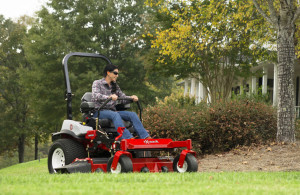While the spring equinox is coming up March 20, many folks across the country have been experiencing spring-like weather for some time now. As your lawn wakes up from its winter slumber, there are things you can start doing almost immediately to clean it up and get a proactive start on maintenance.
A Note on Timing

Paying attention to the needs of your lawn this spring will make it easier to maintain the beauty of your lawn throughout the season.
While it may seem beneficial to get out as soon as the weather begins to warm up, a little patience can go a long way to maximize the results of your work. Wait until your lawn has mostly greened up to begin mowing, aeration or other maintenance. Too much traffic on the lawn before it’s green increases the chances of killing off new shoots before they mature, or compacting the turf.
Turf Type Matters
Understanding whether you’ve got cool-season grasses (such as bluegrass, fescue and rye) or warm-season grasses (such as Bermuda, St. Augustine and Zoysia) is important to knowing which maintenance tasks you’ll need to perform, and when it’s best to perform them.
Cool-season grasses have two primary growth periods: one in the spring and another in the fall. They can struggle and go dormant in the heat of the summer, so spring maintenance should focus on strengthening the lawn to better deal with summer heat.
Warm-season turf grasses begin growing shortly after the final spring frost and hit their full growth stride as the midsummer heat cranks up.
Here are some maintenance items you can perform to help your lawn be more beautiful and weed-free this season, with notes on timing for warm- and cool-season grasses:
- Yard raking/clean-up — Most lawns can use some clean up first thing in the spring. Rake up all leaf and organic material to ensure your lawn is getting the sunlight it needs to green up quickly. As you rake up the leaves in your yard, make note of any areas of the lawn that may be compacted (and need to be aerated) or have excessive thatch (and need to be dethatched).
- Fertilization — You won’t necessarily need to fertilize your lawn in the spring, particularly if you applied fertilizer last fall. But depending on what type of fertilizer program you’re on, spring can be a good time to have your soil tested to check available nutrient levels. Cool-season grasses can benefit from a light fertilizer application in the spring, once they’re actively growing. For warm-season grasses, it’s best to fertilize in late spring — typically in April or May — as soon as the lawn greens up and is actively growing.
- Weed control — Regardless of whether you have warm- or cool-season grasses, a spring application of pre-emergence herbicide can be very beneficial for your lawn. For control of annual weeds such as crabgrass and foxtail, you want to apply the weed control as soon as the soil temperature consistently reaches 55 degrees. Often, your local extension office can help you understand the soil temperatures for your area. If you plan to perform any seeding to your lawn, you will want to choose your herbicide carefully, as most will prevent the germination of grass seed. According to the University of Nebraska Extension in Lancaster County, the only pre-emergence herbicide that can be used with new seeding is siduron, which is commonly sold as Tupersan.
- Seeding — Cool-season grasses can be planted as soon as soil temperatures are consistently in the 50s (and air temps are in the 60s). The goal is to plant as soon as conditions allow to give the grass as much time to establish before the stress of summer heat bears down on it. Fall is a better time to plant cool-season grasses, so your focus for spring planting should ideally be on filling in bare spots. Warm-season grasses should be planted when soil temperatures are consistently in the 60s and all threat of frost has passed.
- Mower maintenance — We covered spring mower maintenance comprehensively in this post from Feb. 17, 2016.
You may find that if your lawn went into the winter in a well-maintained condition, it may not need all of these steps to be ready for spring. Lawn maintenance you performed in the fall, such as aeration or dethatching, may or may not need an additional spring application. It all depends on the condition of your lawn coming out of winter. And if you maintained your mower in the fall, you won’t need to do another comprehensive service in the spring.
For more information:
- Spring Maintenance Techniques for a Healthy Lawn — University of Nebraska Extension in Lancaster County
- Spring Lawn Care Tips — Lawncare.org
- 5 Spring Lawn Care Tips — HowStuffWorks.com
- Spring Lawn Care Guide — TodaysHomeowner.com
- Spring Lawn Care Tips – The Red Light-Green Light Version — Michigan State University Extension






